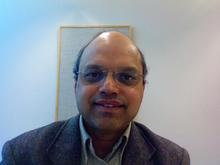Erramilli,Shyamsunder
近期热点
资料介绍
个人简历
M.Sc. Physics, Indian Institute of Technology, Ph.D. Physics, University of IllinoisrProfessor in Biomedical Engineering (Joint), Boston University研究领域
"""Near-field infrared spectroscopy:The Erramilli group works on developing high-resolution infrared microscopy for studying biological systems. Images with spatial and temporal information add to our understanding of these systems. Vibrational spectroscopy is an exquisitely sensitive tool for studying the many biomolecular systems that exhibit characteristic “fingerprint” absorption bands. Combining this sensitivity with microscopy allows the imaging of living systems without using stains or labels. But conventional infrared microscopy is limited to poor spatial resolution set by the diffraction limit associated with the longer wavelengths involved. Scanning near-field infrared microscopy is used to break the diffraction limit without sacrificing the spectral sensitivity. A variety of bright infrared sources are used – broadband synchrotron radiation, free electron lasers, ultra fast tunable infrared lasers, and quantum cascade lasers.Using this system, the first ever high-resolution underwater infrared images of single living cells have been obtained. Images of single fibroblasts at wavelengths at which proteins, nucleic acids, and lipids absorb suggest that cell motion is associated with complex topological changes in the membrane.Currently, time-resolved methods taking advantage of a tunable 100-fs laser are being used to do “vibrational lifetime” imaging in the mid-infrared region of the spectrum.Vibrational dynamics of biomolecular systems are studied using femtosecond single color and two color pump-probe methods, and photon echo studies. Ultrafast studies on anesthetic molecules like nitrous oxide are aimed at solving the long-standing biological physics problem of how anesthetics act.Ultrafast infrared spectroscopy:A multidisciplinary collaboration project that involves the development of an ultra fast multicolor infrared spectrometer in order to study interactions of light on fundamental biological molecules and systems.Single Color IR pump-probe experiments have been used to study the nature of the environment of the anesthetic gas nitrous oxide in water and model membranes. These represent the first utrafast studies on an anesthetic gas N2O, which appears to be exquisitely sensitive to the hydration state of the membrane system [with Prof Ziegler & Prof Rothschild]Studies on vibrational energy relaxation in water have identified a novel energy relaxation pathway, and the dynamics of the combination band [with Prof Ziegler]The experimental studies are combined with Molecular Dynamics simulations to identify the role of ordering of water in nanoconfined systems [with Prof Feng Wang & helpful discussions with Prof Stanley]Visible pump-IR probe studies are used to study photoactive proteins [Prof Rothschild] have shown that the protein backbone responds within 800 femtoseconds of photoexcitation. The studies the first time such a fast response in the protein backbone has been detected in a bacterial proteorhodosin system.2-D IR femtosecond IR spectroscopy:Traditional (1D) infrared spectroscopy can, at best, obtain spectra on a nanosecond time scale, and the spectra contain ambiguously broad lineshapes, which cannot be interpreted. Utilizing multiple ultra fast pulses, varied both in time and frequency, spectra can be obtained on a timescale of several hundred femtoseconds. These multidimensional spectra provide a direct measurement of the mechanism that leads to line width broadening, as well as information on the vibrational couplings in the molecule. The data obtained can be used to determine between homogenous and inhomogeneous broadening and to monitor the structure of a molecule on a femtosecond timescale.A spectra physics Hurricane titanium sapphire laser is used to generate 100 femtosecond pulses, which are tuned to the appropriate wavelength for experimental conditions using non-linear crystals and optical parametric amplifiers. A 64-element HgCdTe array detector is used to study the spectrum over the full bandwidth of the laser pulse."""近期论文
12/14/14 Nonlinear Midinfrared Photothermal Spectroscopy Using Zharov Splitting and Quantum Cascade Lasers08/10/10 Computational investigation of lipid hydration water of Lα 1-palmitoyl-2-oleoyl-sn-glycero- 3-phosphocholine at three hydration levels02/19/10 The potential of mean force of nitrous oxide in a 1,2-dimyristoylphosphatidylcholine lipid bilayer09/13/08 Nitrous Oxide Vibrational Energy Relaxation Is a Probe of Interfacial Water in Lipid Bilayers12/14/07 Nanoscale field effect transistor for biomolecular signal amplification04/03/07 Rheology of Gastric Mucin Exhibits a pH-Dependent Sol-Gel Transition 相关热点
最新收录
- Erramilli,Shyamsunder 11-02
- Emili,Andrew 11-02
- Elliott,SeanJ. 11-02
- Ekinci,Kamil 11-02
- Eisenberg,Sol 11-02
- Economo,Michael 11-02
- Duprex,Paul 11-02
- Dunlop,Mary 11-02
- Duncanson,WynterJ. 11-02
- Dow,Graham 11-02
- Dooms,Hans 11-02
- Doerrer,Linda 11-02
- Dill,Dan 11-02
- Dietze,Michael 11-02
- Densmore,Douglas 11-02

